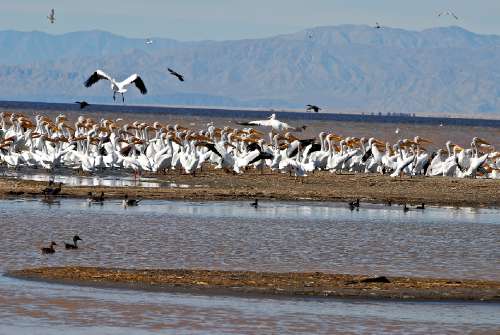RIVERSIDE, Calif. – Created by accident and once a popular tourist destination, the Salton Sea has been the receptacle for run-off of salt, fertilizers and pesticides from the nearly half a million acres of agricultural land that surrounds it. The Salton Sea Initiative at the University of California, Irvine is a multidisciplinary group investigating the sustainability challenges that face the Salton Sea region.
The Center for Ideas and Society at UC Riverside will host a panel on the ecological challenges facing the sea and the communities that surround it on Monday, Nov. 10, from 4 to 5:30 p.m. in College Building South. The event is free and open to the public. Parking permits may be purchased at the kiosk on West Campus Drive at the University Avenue entrance to the campus.
The panel will feature Gregor Yanega, an ornithologist and academic advisor for the Salton Sea Initiative at UCI; Mark Matsumoto, UCR professor of chemical and environmental engineering; and Michael Anderson, UCR professor of soil chemistry.
The Salton Sea is one of the world’s largest inland seas and, at -227 feet below sea level, one of the lowest places on Earth. It is located in a geological depression between the Imperial and Coachella valleys that has alternated between freshwater lake, saline lake, and dry desert basin for hundreds of thousands of years.
The current sea formed when the Colorado River breached canal gates leading into the Imperial Valley in 1905-06. Marine life was introduced and the Salton Sea became a popular tourist destination during the 1940s, ‘50s and ‘60s. It remains an important stopover for migratory birds. However, increasing salinity in the last half of the 20th century has left the Salton Sea uninhabitable by most marine fish.
In 2013 UC Irvine established the Salton Sea Initiative to help address multiple sustainability issues facing the region, among them desalination, biological remediation, nutrient removal, public health issues, economic development, land use, and water allocation.
The Salton Sea panel is part of a series of lectures, seminars and workshops the Center for Ideas and Society will present in 2014-15 exploring “the nature of nature” in a world where the distinctions between what is natural and man-made grow increasingly blurred, said Georgia Warnke, professor of political science and director of the center.
This exploration includes a collaboration with Proteus Gowanus, an interdisciplinary gallery and reading room in Brooklyn, N.Y., that supports artists and non-artists in creative engagement with a diverse public, she said.
“The initiative and the Proteus series will ask the question, ‘What is natural?’” Warnke explained. “The institutions will share speakers and resources in order to examine the premises, presuppositions and concerns behind efforts to restore native plant habitats, to reintroduce wild species into environments from which they have been displaced, to re-create extinct species, to re-create ourselves and more.”
Read original article: http://ucrtoday.ucr.edu/25514

